Modern life is filled with pings, notifications, and constant updates. The tools meant to simplify your day often end up demanding your attention at every turn. True balance is not about disconnecting completely but about learning to exist calmly within a connected environment. Finding digital balance is an intentional act, one that restores focus, peace, and a sense of control over the noise.
The Illusion of Constant Connection
Connectivity has become a symbol of productivity. The more reachable you are, the more capable you appear. Yet, constant access can easily blur the boundaries between attention and distraction. Every unread message or open tab divides your focus into smaller pieces. The goal of digital balance is to rebuild the spaces in between, to let silence, reflection, and rest become part of your online rhythm. It begins with understanding that presence is not the same as engagement.
Redefining Productivity Through Simplicity
Digital systems were created to make tasks easier, but the overload of tools can create complexity instead. Simplifying what you use and how you use it can restore balance. Choosing fewer apps, turning off nonessential notifications, and organizing information with clarity are all ways to bring structure to digital life. This same principle applies beyond screens.
Platforms such as shiply.com demonstrate how simplicity and trust can turn a stressful task into a seamless experience. By connecting users directly with rated shipping companies, Shiply removes the confusion from finding reliable services, proving that thoughtful digital design can make even complex processes feel calm and transparent. It is a real-world example of how technology can reduce mental noise instead of adding to it.
The Role of Boundaries in Digital Calm
Balance thrives where limits are respected. Creating boundaries in the digital world does not mean isolation; it means intentional interaction. Setting clear times for work, rest, and communication helps retrain the brain to recognize priority over impulse. The act of pausing before replying or checking notifications is small but powerful. These moments of restraint remind you that control over technology still belongs to the user, not the device. By setting boundaries, you protect both your focus and your peace of mind.
Cultivating Stillness in a Connected Environment
Stillness does not always mean silence. It can be the calm that comes from order, clarity, and purpose. Digital stillness is achieved when technology serves as a tool rather than a distraction. Simple practices, such as decluttering screens, creating visual harmony in workspaces, or organizing digital files, help restore a sense of calm. The idea is not to reject connection but to engage with intention. Technology can be part of tranquility when used thoughtfully and sparingly.
A Choice for Clarity
Digital balance is not a one-time achievement but a continuing practice. It requires reflection, discipline, and a willingness to simplify. The calm you seek in a hyperconnected world is not found in more technology but in wiser use of it. By curating what you allow into your attention, you rediscover clarity in both thought and action.
The beauty of balance lies in moderation. When your devices work quietly in the background instead of demanding constant input, you can reclaim time, focus, and presence. Digital calm is not a luxury, it is the modern definition of living with awareness and control.

